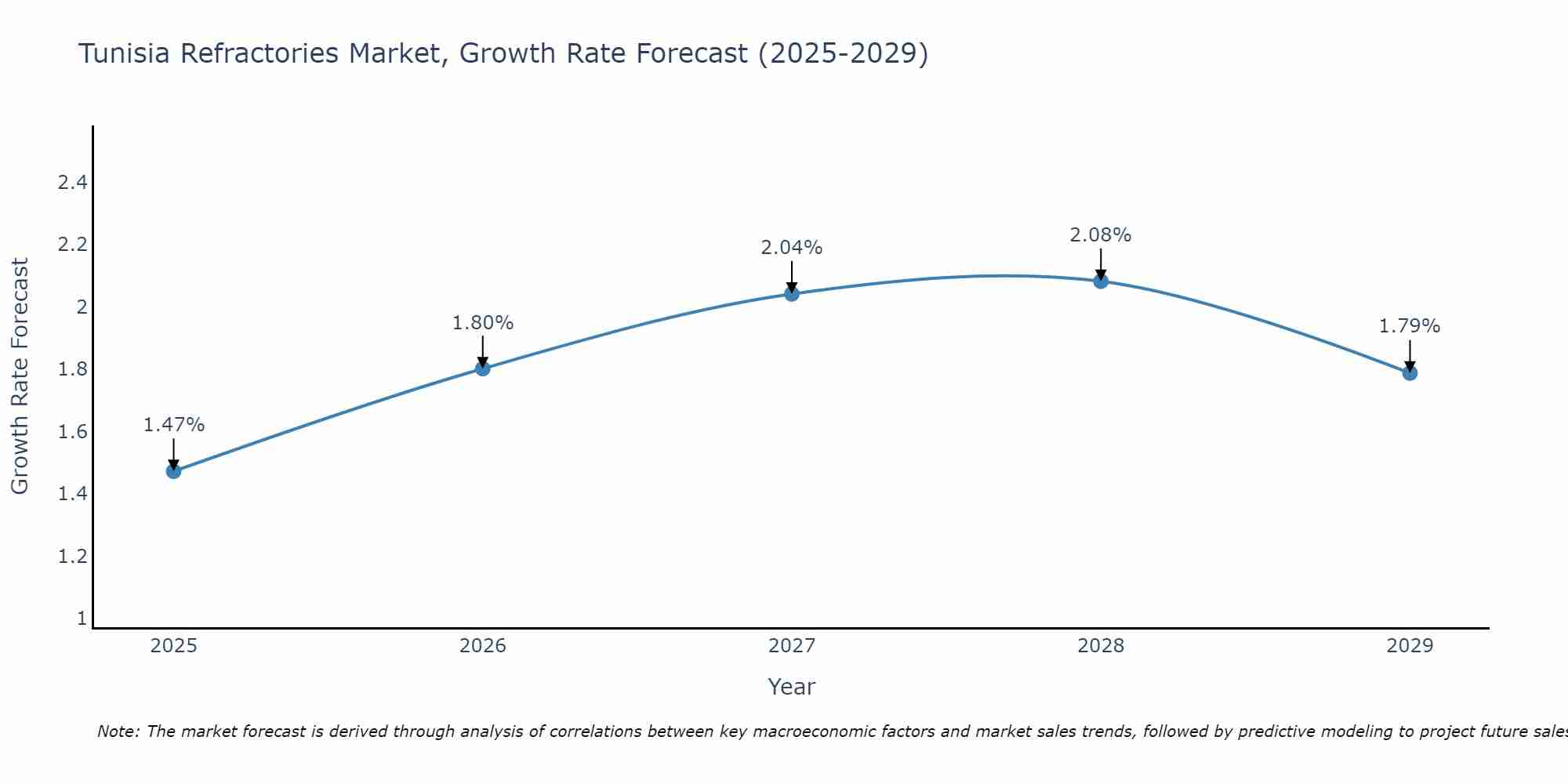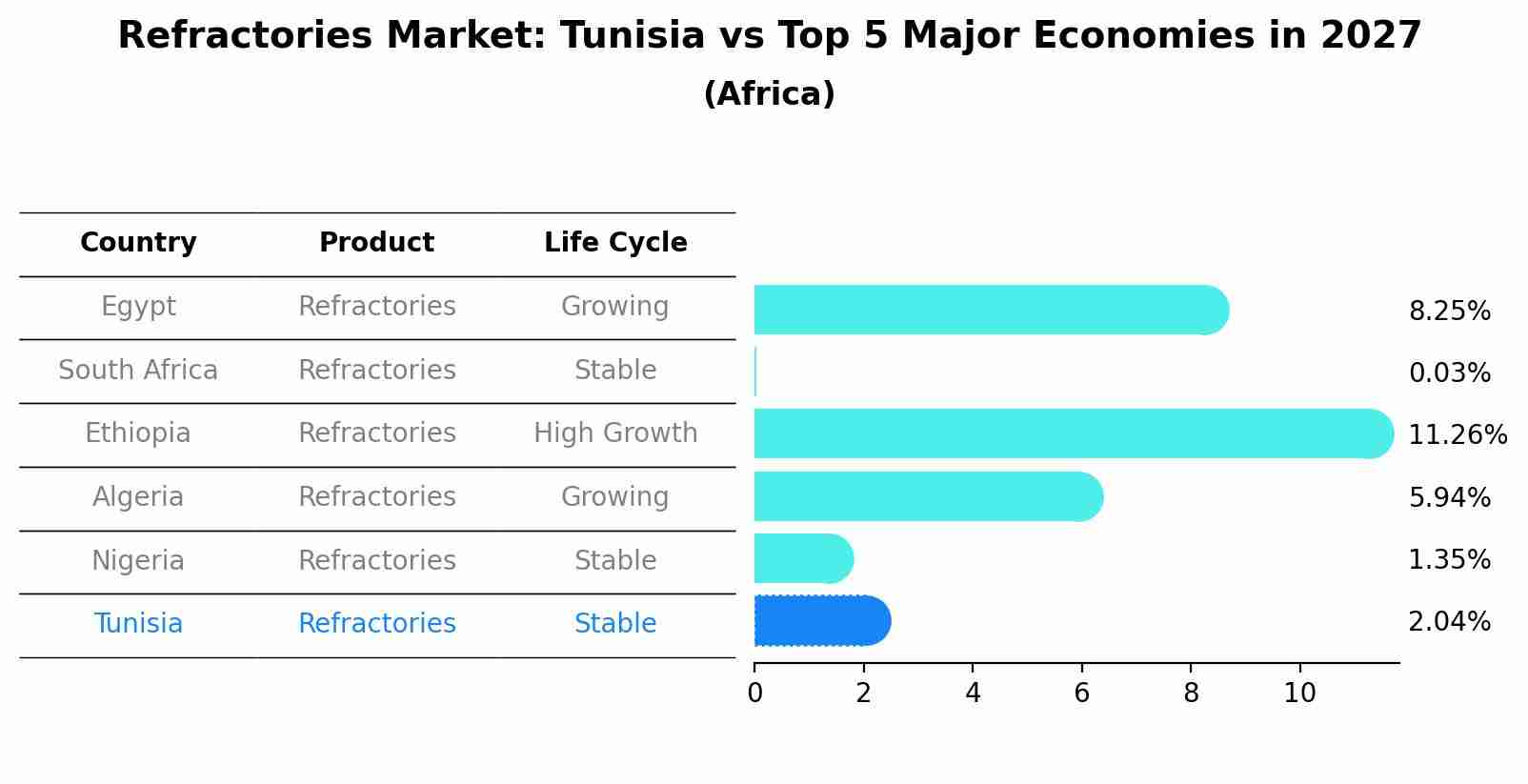Tunisia Refractories Market (2025-2031) | Companies, Share, Forecast, COVID-19 IMPACT, Growth, Revenue, Outlook, Industry, Size, Value, Analysis & Trends
| Product Code: ETC008714 | Publication Date: Oct 2020 | Updated Date: Apr 2025 | Product Type: Report | |
| Publisher: 6Wresearch | Author: Ravi Bhandari | No. of Pages: 70 | No. of Figures: 35 | No. of Tables: 5 |
Tunisia Refractories Market Size Growth Rate
The Tunisia Refractories Market is projected to witness mixed growth rate patterns during 2025 to 2029. Starting at 1.47% in 2025, the market peaks at 2.08% in 2028, and settles at 1.79% by 2029.

Refractories Market: Tunisia vs Top 5 Major Economies in 2027 (Africa)
In the Africa region, the Refractories market in Tunisia is projected to expand at a stable growth rate of 2.04% by 2027. The largest economy is Egypt, followed by South Africa, Ethiopia, Algeria and Nigeria.

Tunisia Refractories Market Overview
The refractories market in Tunisia is driven by the country`s industrial activities, particularly in steel, cement, and glass manufacturing, where high-temperature resistance materials are essential. Refractories are used to line furnaces, kilns, and reactors, providing thermal insulation and protection against thermal shock and chemical corrosion. Market growth is supported by industrial expansion and modernization efforts. Challenges include the need for high-quality raw materials, competition from alternative materials, and environmental regulations impacting production processes.
Drivers of the market
The refractories market in Tunisia is driven by the growth of the construction and industrial sectors. Refractories are essential for high-temperature applications in industries such as steel, cement, and glass. The increasing demand for infrastructure development and the expansion of industrial activities fuel the need for high-quality refractory materials.
Challenges of the market
The Tunisia refractories market deals with challenges like the high cost of raw materials, the need for technological advancements to improve refractory performance, and competition from alternative materials. Additionally, the market is affected by the slowdown in key end-use industries such as steel and cement, and environmental regulations regarding emissions from refractory production processes.
Government Policy of the market
The Tunisian government supports the refractories market through industrial policies that promote the development of key sectors such as steel, cement, and glass, which are major consumers of refractory materials. Policies include tax breaks and subsidies for local manufacturers of refractory products and stringent quality standards to ensure high performance and durability of refractories used in industrial processes.
Key Highlights of the Report:
- Tunisia Refractories Market Outlook
- Market Size of Tunisia Refractories Market, 2024
- Forecast of Tunisia Refractories Market, 2031
- Historical Data and Forecast of Tunisia Refractories Revenues & Volume for the Period 2021-2031
- Tunisia Refractories Market Trend Evolution
- Tunisia Refractories Market Drivers and Challenges
- Tunisia Refractories Price Trends
- Tunisia Refractories Porter's Five Forces
- Tunisia Refractories Industry Life Cycle
- Historical Data and Forecast of Tunisia Refractories Market Revenues & Volume By Form Types for the Period 2021-2031
- Historical Data and Forecast of Tunisia Refractories Market Revenues & Volume By Shaped Refractories for the Period 2021-2031
- Historical Data and Forecast of Tunisia Refractories Market Revenues & Volume By Unshaped Refractories for the Period 2021-2031
- Historical Data and Forecast of Tunisia Refractories Market Revenues & Volume By Product Types for the Period 2021-2031
- Historical Data and Forecast of Tunisia Refractories Market Revenues & Volume By Non-clay Refractory for the Period 2021-2031
- Historical Data and Forecast of Tunisia Refractories Market Revenues & Volume By Clay Refractory for the Period 2021-2031
- Historical Data and Forecast of Tunisia Refractories Market Revenues & Volume By End-users for the Period 2021-2031
- Historical Data and Forecast of Tunisia Refractories Market Revenues & Volume By Iron & Steel for the Period 2021-2031
- Historical Data and Forecast of Tunisia Refractories Market Revenues & Volume By Cement for the Period 2021-2031
- Historical Data and Forecast of Tunisia Refractories Market Revenues & Volume By Non-Ferrous Metals for the Period 2021-2031
- Historical Data and Forecast of Tunisia Refractories Market Revenues & Volume By Glass for the Period 2021-2031
- Historical Data and Forecast of Tunisia Refractories Market Revenues & Volume By Others for the Period 2021-2031
- Tunisia Refractories Import Export Trade Statistics
- Market Opportunity Assessment By Form Types
- Market Opportunity Assessment By Product Types
- Market Opportunity Assessment By End-users
- Tunisia Refractories Top Companies Market Share
- Tunisia Refractories Competitive Benchmarking By Technical and Operational Parameters
- Tunisia Refractories Company Profiles
- Tunisia Refractories Key Strategic Recommendations
Frequently Asked Questions About the Market Study (FAQs):
1 Executive Summary |
2 Introduction |
2.1 Key Highlights of the Report |
2.2 Report Description |
2.3 Market Scope & Segmentation |
2.4 Research Methodology |
2.5 Assumptions |
3 Tunisia Refractories Market Overview |
3.1 Tunisia Country Macro Economic Indicators |
3.2 Tunisia Refractories Market Revenues & Volume, 2021 & 2031F |
3.3 Tunisia Refractories Market - Industry Life Cycle |
3.4 Tunisia Refractories Market - Porter's Five Forces |
3.5 Tunisia Refractories Market Revenues & Volume Share, By Form Types, 2021 & 2031F |
3.6 Tunisia Refractories Market Revenues & Volume Share, By Product Types, 2021 & 2031F |
3.7 Tunisia Refractories Market Revenues & Volume Share, By End-users, 2021 & 2031F |
4 Tunisia Refractories Market Dynamics |
4.1 Impact Analysis |
4.2 Market Drivers |
4.3 Market Restraints |
5 Tunisia Refractories Market Trends |
6 Tunisia Refractories Market, By Types |
6.1 Tunisia Refractories Market, By Form Types |
6.1.1 Overview and Analysis |
6.1.2 Tunisia Refractories Market Revenues & Volume, By Form Types, 2021-2031F |
6.1.3 Tunisia Refractories Market Revenues & Volume, By Shaped Refractories, 2021-2031F |
6.1.4 Tunisia Refractories Market Revenues & Volume, By Unshaped Refractories, 2021-2031F |
6.2 Tunisia Refractories Market, By Product Types |
6.2.1 Overview and Analysis |
6.2.2 Tunisia Refractories Market Revenues & Volume, By Non-clay Refractory, 2021-2031F |
6.2.3 Tunisia Refractories Market Revenues & Volume, By Clay Refractory, 2021-2031F |
6.3 Tunisia Refractories Market, By End-users |
6.3.1 Overview and Analysis |
6.3.2 Tunisia Refractories Market Revenues & Volume, By Iron & Steel, 2021-2031F |
6.3.3 Tunisia Refractories Market Revenues & Volume, By Cement, 2021-2031F |
6.3.4 Tunisia Refractories Market Revenues & Volume, By Non-Ferrous Metals, 2021-2031F |
6.3.5 Tunisia Refractories Market Revenues & Volume, By Glass, 2021-2031F |
6.3.6 Tunisia Refractories Market Revenues & Volume, By Others, 2021-2031F |
7 Tunisia Refractories Market Import-Export Trade Statistics |
7.1 Tunisia Refractories Market Export to Major Countries |
7.2 Tunisia Refractories Market Imports from Major Countries |
8 Tunisia Refractories Market Key Performance Indicators |
9 Tunisia Refractories Market - Opportunity Assessment |
9.1 Tunisia Refractories Market Opportunity Assessment, By Form Types, 2021 & 2031F |
9.2 Tunisia Refractories Market Opportunity Assessment, By Product Types, 2021 & 2031F |
9.3 Tunisia Refractories Market Opportunity Assessment, By End-users, 2021 & 2031F |
10 Tunisia Refractories Market - Competitive Landscape |
10.1 Tunisia Refractories Market Revenue Share, By Companies, 2024 |
10.2 Tunisia Refractories Market Competitive Benchmarking, By Operating and Technical Parameters |
11 Company Profiles |
12 Recommendations |
13 Disclaimer |
- Single User License$ 1,995
- Department License$ 2,400
- Site License$ 3,120
- Global License$ 3,795
Search
Related Reports
- Portugal Occupational Health & Safety Services Market (2025-2031) | Strategy, Consumer Insights, Analysis, Investment Trends, Opportunities, Growth, Size, Share, Industry, Revenue, Segments, Value, Segmentation, Supply, Forecast, Restraints, Outlook, Competition, Drivers, Trends, Demand, Pricing Analysis, Competitive, Strategic Insights, Companies, Challenges
- Netherlands Occupational Health and Safety Services Market (2025-2031) | Strategy, Consumer Insights, Analysis, Investment Trends, Opportunities, Growth, Size, Share, Industry, Revenue, Segments, Value, Segmentation, Supply, Forecast, Restraints, Outlook, Competition, Drivers, Trends, Demand, Pricing Analysis, Competitive, Strategic Insights, Companies, Challenges
- Belgium and Luxembourg Facility Management Market (2025-2031) | Strategy, Consumer Insights, Analysis, Investment Trends, Opportunities, Growth, Size, Share, Industry, Revenue, Segments, Value, Segmentation, Supply, Forecast, Restraints, Outlook, Competition, Drivers, Trends, Demand, Pricing Analysis, Competitive, Strategic Insights, Companies, Challenges
- Russia Women Intimate Apparel Market (2025-2031) | Strategy, Consumer Insights, Analysis, Investment Trends, Opportunities, Growth, Size, Share, Industry, Revenue, Segments, Value, Segmentation, Supply, Forecast, Restraints, Outlook, Competition, Drivers, Trends, Demand, Pricing Analysis, Competitive, Strategic Insights, Companies, Challenges
- Africa Chocolate Market (2025-2031) | Size, Share, Trends, Growth, Revenue, Analysis, Forecast, industry & Outlook
- Global Hydroxychloroquine And Chloroquine Market (2025-2031) | Industry, Trends, Size, Outlook, Growth, Value, Companies, Revenue, Analysis, Share, Forecast
- Saudi Arabia Plant Maintenance Market (2025-2031) | Industry, Size, Growth, Revenue, Value, Companies, Forecast, Analysis, Share & Trends
- Taiwan Electric Truck Market (2025-2031) | Outlook, Industry, Revenue, Size, Forecast, Growth, Analysis, Share, Companies, Value & Trends
- South Korea Electric Bus Market (2025-2031) | Outlook, Industry, Companies, Analysis, Size, Revenue, Value, Forecast, Trends, Growth & Share
- Africa Low Temperature Powder Coating Market (2025-2031) | Companies, Competition, Size, Challenges, Segmentation, Trends, Competitive, Industry, Supply, Strategy, Investment Trends, Growth, Segments, Restraints, Strategic Insights, Revenue, Share, Forecast, Drivers, Analysis, Pricing Analysis, Demand, Consumer Insights, Value, Opportunities, Outlook
Industry Events and Analyst Meet
Our Clients
Whitepaper
- Middle East & Africa Commercial Security Market Click here to view more.
- Middle East & Africa Fire Safety Systems & Equipment Market Click here to view more.
- GCC Drone Market Click here to view more.
- Middle East Lighting Fixture Market Click here to view more.
- GCC Physical & Perimeter Security Market Click here to view more.
6WResearch In News
- Doha a strategic location for EV manufacturing hub: IPA Qatar
- Demand for luxury TVs surging in the GCC, says Samsung
- Empowering Growth: The Thriving Journey of Bangladesh’s Cable Industry
- Demand for luxury TVs surging in the GCC, says Samsung
- Video call with a traditional healer? Once unthinkable, it’s now common in South Africa
- Intelligent Buildings To Smooth GCC’s Path To Net Zero













